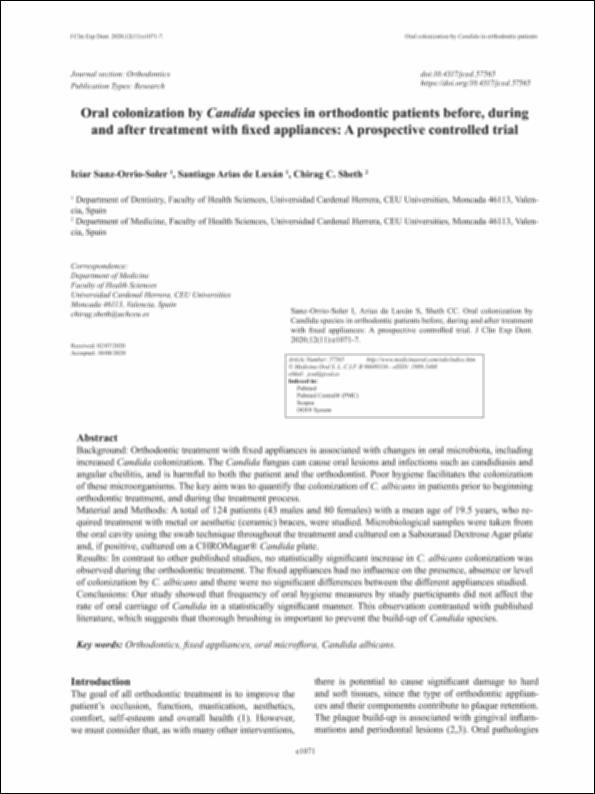Por favor, use este identificador para citar o enlazar este ítem:
http://hdl.handle.net/10637/12861Oral colonization by Candida species in orthodontic patients before, during and after treatment with fixed appliances : a prospective controlled trial
| Título : | Oral colonization by Candida species in orthodontic patients before, during and after treatment with fixed appliances : a prospective controlled trial |
| Autor : | Sanz-Orrio Soler, Icíar Sheth Shah, Chirag Chandrakant Arias de Luxán, Santiago |
| Materias: | Cándida albicans - Tratamiento.; Fungicidas.; Candida Albicans - Treatment.; Ortodoncia.; Orthodontics.; Fungicides. |
| Editorial : | Medicina Oral. |
| Citación : | Sanz-Orrio-Soler, I., Arias de Luxán, S. & Sheth, C.C. (2020). Oral colonization by Candida species in orthodontic patients before, during and after treatment with fixed appliances: a prospective controlled trial. Journal of Clinical and Experimental Dentistry, vol. 12, i. 11 (01 nov.), pp. e1071-e1077. DOI: https://doi.org/10.4317/jced.57565 |
| Resumen : | Background: Orthodontic treatment with fixed appliances is associated with changes in oral microbiota, including increased Candida colonization. The Candida fungus can cause oral lesions and infections such as candidiasis and angular cheilitis, and is harmful to both the patient and the orthodontist. Poor hygiene facilitates the colonization of these microorganisms. The key aim was to quantify the colonization of C. albicans in patients prior to beginning orthodontic treatment, and during the treatment process. Material and Methods: A total of 124 patients (43 males and 80 females) with a mean age of 19.5 years, who required treatment with metal or aesthetic (ceramic) braces, were studied. Microbiological samples were taken from the oral cavity using the swab technique throughout the treatment and cultured on a Sabouraud Dextrose Agar plate and, if positive, cultured on a CHROMagar® Candida plate. Results: In contrast to other published studies, no statistically significant increase in C. albicans colonization was observed during the orthodontic treatment. The fixed appliances had no influence on the presence, absence or level of colonization by C. albicans and there were no significant differences between the different appliances studied. Conclusions: Our study showed that frequency of oral hygiene measures by study participants did not affect the rate of oral carriage of Candida in a statistically significant manner. This observation contrasted with published literature, which suggests that thorough brushing is important to prevent the build-up of Candida species. |
| Descripción : | Este artículo se encuentra disponible en la siguiente URL: http://www.medicinaoral.com/medoralfree01/aop/57565.pdf |
| URI : | http://hdl.handle.net/10637/12861 |
| Derechos: | http://creativecommons.org/licenses/by/4.0/deed.es |
| ISSN : | 1989-5488. |
| Fecha de publicación : | 1-nov-2020 |
| Centro : | Universidad Cardenal Herrera-CEU |
| Aparece en las colecciones: | Dpto. Odontología |
Los ítems de DSpace están protegidos por copyright, con todos los derechos reservados, a menos que se indique lo contrario.


